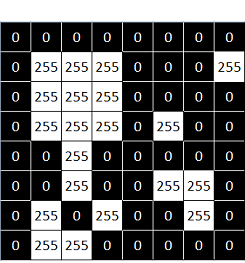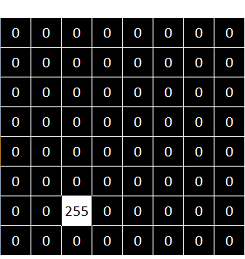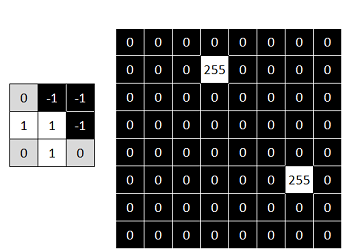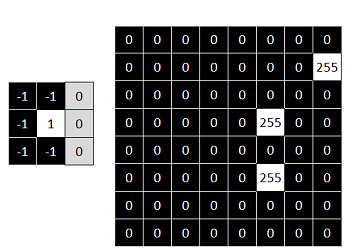Hit-or-Miss Morphological Operation
In this tutorial you will learn how to find a given configuration or pattern in a binary image by using the Hit-or-Miss transform (also known as Hit-and-Miss transform).
This transform is also the basis of more advanced morphological operations such as thinning or pruning.
We will use the OpenCV function cv.morphologyEx.
Sources:
Contents
Theory
Morphological operators process images based on their shape. These operators apply one or more structuring elements to an input image to obtain the output image. The two basic morphological operations are the erosion and the dilation. The combination of these two operations generate advanced morphological transformations such as opening, closing, or top-hat transform. To know more about these and other basic morphological operations refer to previous demos.
The Hit-or-Miss transformation is useful to find patterns in binary images. In particular, it finds those pixels whose neighbourhood
matches the shape of a first structuring element ![]() while not matching the shape of a second structuring element
while not matching the shape of a second structuring element ![]() at the same time. Mathematically, the operation applied to an image
at the same time. Mathematically, the operation applied to an image ![]() can be expressed as follows:
can be expressed as follows:
![]()
Therefore, the hit-or-miss operation comprises three steps:
*# Erode image ![]() with structuring element
with structuring element ![]() . *# Erode the complement of image
. *# Erode the complement of image ![]() (
(![]() ) with structuring element
) with structuring element ![]() . *# AND results from step 1 and step 2.
. *# AND results from step 1 and step 2.
The structuring elements ![]() and
and ![]() can be combined into a single element
can be combined into a single element ![]() . Let's see an example:
. Let's see an example:

Structuring elements (kernels). Left: kernel to 'hit'. Middle: kernel to 'miss'. Right: final combined kernel
In this case, we are looking for a pattern in which the central pixel belongs to the background while the north, south, east, and west pixels belong to the foreground. The rest of pixels in the neighbourhood can be of any kind, we don't care about them. Now, let's apply this kernel to an input image:

You can see that the pattern is found in just one location within the image.

Other examples
Here you can find the output results of applying different kernels to the same input image used before:
- Kernel and output result for finding top-right corners

- Kernel and output result for finding left end points

Now try your own patterns!
Code
function hitmiss_demo()input image
img = 255 * uint8([
0 0 0 0 0 0 0 0; ...
0 1 1 1 0 0 0 1; ...
0 1 1 1 0 0 0 0; ...
0 1 1 1 0 1 0 0; ...
0 0 1 0 0 0 0 0; ...
0 0 1 0 0 1 1 0; ...
0 1 0 1 0 0 1 0; ...
0 1 1 0 0 0 0 0
]);
figure, show_image(img), title('Original')
structuring element
kernel = int32([0 1 0; 1 -1 1; 0 1 0]);
figure, show_image(kernel), colorbar, title('Kernel')
hit-or-mess operation
out = cv.morphologyEx(img, 'HitMiss', 'Element',kernel); figure, show_image(out), title('Hit or Miss')

endfunction show_image(img) % pad because PCOLOR chops off last row and column img = cv.copyMakeBorder(img, [0 1 0 1], 'BorderType','Constant'); if mexopencv.isOctave() img = double(img); end h = pcolor(img); set(h, 'EdgeColor','b'); set(gca, 'XAxisLocation','top') axis image ij, colormap(gray(3)) end